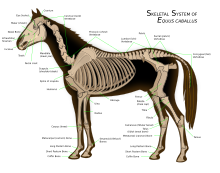
The limbs of the horse are structures made of dozens of bones, joints, muscles, tendons, and ligaments that support the weight of the equine body. They include two apparatuses: the suspensory apparatus, which carries much of the weight, prevents overextension of the joint and absorbs shock, and the stay apparatus, which locks major joints in the limbs, allowing horses to remain standing while relaxed or asleep. The limbs play a major part in the movement of the horse, with the legs performing the functions of absorbing impact, bearing weight, and providing thrust. In general, the majority of the weight is borne by the front legs, while the rear legs provide propulsion. The hooves are also important structures, providing support, traction and shock absorption, and containing structures that provide blood flow through the lower leg. As the horse developed as a cursorial animal, with a primary defense mechanism of running over hard ground, its legs evolved to the long, sturdy, light-weight, one-toed form seen today.
Good conformation in the limbs leads to improved movement and decreased likelihood of injuries. Large differences in bone structure and size can be found in horses used for different activities, but correct conformation remains relatively similar across the spectrum. Structural defects, as well as other problems such as injuries and infections, can cause lameness, or movement at an abnormal gait. Injuries to and problems with horse legs can be relatively minor, such as stocking up, which causes swelling without lameness, or quite serious. Even leg injuries that are not immediately fatal may still be life-threatening to horses, as their bodies are adapted to bear weight on all four legs and serious problems can result if this is not possible.
